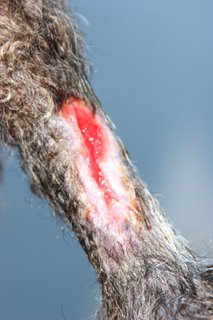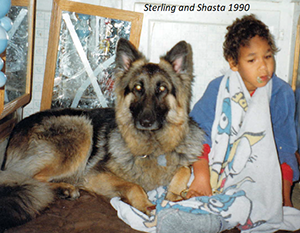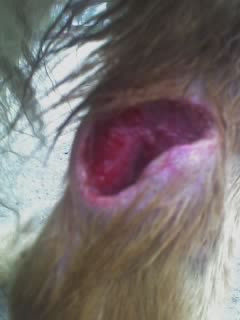My Beautiful Dog Was Dying
By Shirley, author of this website
 When the conventional veterinarian suggested to euthanize my 2 year old
German Shepherd dog because "nothing could be done to stop her suffering and to cure her"
I turned to holistic treatments. Shasta fully recovered and lived 10 more years in excellent health.
When the conventional veterinarian suggested to euthanize my 2 year old
German Shepherd dog because "nothing could be done to stop her suffering and to cure her"
I turned to holistic treatments. Shasta fully recovered and lived 10 more years in excellent health.
When Shasta joined our family at age 2, she was in extremely poor health:
severely emaciated and weak with chronic diarrhea; massive wax discharge from
her ears which were continually irritated and inflamed and she also had an a
ongoing eye and nasal discharge; skin disorder with carbuncles and hotspots.
The veterinarian thought she had been a neglected or abused dog but his was
not so. The breeder had done her best to take "good care" of her champion dogs;
she fed them the 'best commercial dog food' for working dogs, dewormed them
with drugs on a regular basis and routinely vaccinated them since puppy hood
against a number of common dog diseases.
A few weeks after I adopted her, Shasta developed masticatory muscle myositis (MMM)
a painful paralysis of the muscle of her jaw bones
which prevented her from opening her mouth, eating, barking, and yawning. The conventional
veterinarian who examined her gave a bleak prognosis. He warned me that Shasta's
immune system was failing, and that the myositis symptoms were going to gradually
worsen and eventually become fatal. He said there was nothing veterinary medicine
could do to help her and suggested that euthanize her (put her to sleep.)
I brought Shasta back home and began researching holistic treatments for
her. I was familiar with holistic medicine because it had saved my life. I had
been struggling with failing health for decades and almost died at the hands of doctors and their drugs.
Homeopathic remedies and a transition to a healthy diet had restored my health and I knew that I could help restore
Shasta's health as well by focusing on rehabilitating her weak and crippled immune system and she rapidly recovered the use of her jaws.
 Shasta was also obsessively licking and biting her
tail and paws which had become painful and swollen filled with clear fluid. The areas were very sore and
very itchy. She would bite till the area became bloody.
Shasta was also obsessively licking and biting her
tail and paws which had become painful and swollen filled with clear fluid. The areas were very sore and
very itchy. She would bite till the area became bloody.
I learned from holistic veterinarians that the symptoms were the direct result of
adverse reaction to vaccines. Correctly prescribed homeopathic
remedies can often undue the damage caused by vaccines.
Homeopathy is noted for its success to antidote or remove the toxic effects of vaccines
and to re-establish balance in the organism and restore health.
Certain homeopathic remedies taken after vaccination can minimize
vaccine damage. A professional homeopathic vet should be consulted
for more information. Holistic veterinarians also use a natural immune modulator
before and after vaccination reduce the adverse reactions by protecting
the integrity of the immune system.
When she turned 10 years old Shasta has experienced a series of illnesses: abscess, VKS syndrome/toxoplasmosis,
and a stroke/paralysis. I treated her at home with homeopathic and herbal remedies
and she fully recovered without drugs or surgery.
SHASTA'S RAW FOOD DIET
RAW food recipe: This is what I feed Shasta everyday: First of all, I feed her only a
raw food diet. I choose to feed her organically grown
fresh vegetables whenever possible. Over 400 pesticides are currently licensed
for use on America's foods and over 2.5 billion pounds are dumped on crop lands,
forests, lawns, and fields annually. There can be anywhere from four to 25 different
pesticides used on conventionally grown produce with tolerances set for only
individual pesticides, without consideration of the combined effect of multiple
pesticides in the conventionally grown foods we consume.
1. In their natural, RAW form, I puree a variety of organically grown vegetables
in the food processor:
(Definition of raw: uncooked, unheated, unprocessed, unadulterated. I have fed Shasta all sorts of raw
vegetables: carrots, eggplants, tomatoes, avocados, lettuce, cabbage, beets,
broccoli, cauliflower, chia seeds etc.
I also feed her the veggie's fiber/pulp that I save when I make vegetable juice and wheatgrass juice for my family. Raw vegetables
are a very important source of vitamins and minerals as well as fiber. Merchants
at our local weekly farmer's market know that I feed Shasta fresh produce and
they often give me slightly damaged or overripe avocados, lettuce and other
veggies which they would normally discard.
Update May 2007 - I discovered a new way of feeding my dog veggies.
Instead of storing my the pulp of my
green juice in the refrigerator or freezer until I am ready to prepare a batch
of raw dog food, I store the pulp in an airtight container at room temperature.
A month or two later, the pulp is completely
decomposed or pre-digested by
naturally occurring friendly bacterias. This is "yogurt" for my dog, shock-full
of nutrients and pro-biotics. It smells like poop, and the dog loves it!
 Some people warn against feeding dogs broccoli, cabbage
or cauliflower (cruciferous plants) because they claim that it can produce gas,
which may at some point cause a portion of their belly to invert, requiring
euthanasia or surgery. Other people say that broccoli and cauliflower should
be lightly blanched (lightly steamed) in order to rid them of the harmful toxins.
Shasta and Kuuma have never had gas from their food, let
alone an inverted belly. I've also heard that
an overuse of cruciferous plants can interfere with thyroid functioning in people
and animals. I give Shasta small amount of cruciferous plants. They have never
suffered any adverse effects from these vegetables. I feed her mostly grounded
or pureed raw carrots and the pulp from my green juice
Some people warn against feeding dogs broccoli, cabbage
or cauliflower (cruciferous plants) because they claim that it can produce gas,
which may at some point cause a portion of their belly to invert, requiring
euthanasia or surgery. Other people say that broccoli and cauliflower should
be lightly blanched (lightly steamed) in order to rid them of the harmful toxins.
Shasta and Kuuma have never had gas from their food, let
alone an inverted belly. I've also heard that
an overuse of cruciferous plants can interfere with thyroid functioning in people
and animals. I give Shasta small amount of cruciferous plants. They have never
suffered any adverse effects from these vegetables. I feed her mostly grounded
or pureed raw carrots and the pulp from my green juice
To flavor the veggies and make them palatable, I thoroughly mix in the following:
- Plenty of raw eggs (I pulverize the eggs with their shells in
the blender. The shells are an excellent source of calcium and other minerals.)
I wouldn't think to feed Shasta corporate-industrial-farmed-produced eggs
where a million beakless chicken are cramped into dark cages and soaked
with antibiotics and hormones. I feed her only fresh eggs, produces by free-ranged,
antibiotics and hormones free chickens. These eggs are available at health
food stores and outdoors farmer's markets. (Some people only give eggs to
their dogs once or twice a week. Wild animals do not eat eggs everyday.
Maybe they eat eggs only during the egg-laying season. Perhaps it is not
wise for me to give eggs to my dog everyday but whipped eggs are very convenient
to flavor her veggies and her sea kelp
and make these palatable.)
- Raw meat: Any type of meat: ground beef or pork, beef stew meat,
organ meat like heart, beef tripes, etc. I do NOT feed her lean meats. Fat
plays an important role in the digestion process and in maintaining an animal's
health - as long as it is RAW fat. Raw beef liver is good, but Dr. Chambreau
recommends that liver must be organic
or do not feed it (or eat it yourself) because it is the detoxifier of the
body, therefore loaded with toxins. I tried to give her other organ meats
such as kidney and spleen but she didn't like it. It is important not
give your pet only muscle meat. Organ meats are important. I use ground
beef ONLY to flavor her vegetables. Dr. Chambreau writes that "ground meat
is passable for most animals, occasionally, but Juliette de Bairacli Levy
said that "minced meat is lethal to animals" and we find in practice that
some animals just do not seem to be healthy until on chunks of raw meat."
- Raw fish. I used to give Shasta a whole raw fish (with bones).
She loved it and ate the head, tail, bones and all. She liked especially
the mackerel. Unfortunately, I've had to stop giving her fish due to mercury
contamination. The Food and Drug Administration (FDA) has issued
advise on the hazard
posed by mercury in fish bought from stores and restaurants, which includes
ocean and coastal fish as well as other types of commercial fish. My entire
family has stopped eating fish.
- Occasionally I mix grounded raw nuts, raw cottage cheese
or raw yogurt to flavor her vegetables.
- Bison paunch manure - Frozen paunch manure from 100%
grass-fed bison is available from Lindner Bison company (No drugs, hormones, chemicals of any kind are
used on the bison or on the grounds that grow the grass and hay that they eat.)
- I do NOT feed cooked grains to Shasta. Why
grains may be harmful to carnivores.

Omega3 fats, Minerals and Vitamins
Our soil, plants, and especially commercial foods are woefully deficient in
key nutrients the following supplements
to Shasta's diet to maintain her optimum health. Some of the ingredients are
recommended in Juliette de Bairacli Levy's book The Complete
Herbal Handbook for the Dog and Cat
To her meals, I add:
- About 1/2 to 1 tablespoon of dry
kelp meal (marine plants) mixed
in her meal. Marine phytoplankton also provide
important trace minerals and vital nutrients.
- Caldera Greens Living Mineral-Rich Whole Food - An organic 100% pure
juice powder concentrate from fresh young, certified organic barley, alfalfa,
wheat, and oat grass grown on volcanic soil. This fresh juiced grass formulation
provides one of the most balanced nutrient profiles of all greens products
available on the market. (Make sure to select the Plain/Natural Flavored
Caldera Greens Powder)
- About 1/2 cup of soaked chia seeds,
a rich source of essential omega-3 oil, antioxidants and natural vitamins.
- About a teaspoon of ancient mineral
magnesium oil to my dog's food or drinking water. (a quart bowl)
- About 1/4 to 1/2 teaspoon of dry clay powder
mixed in her meal. (I never use fluoridated, chlorinated toxic tap water).
- About a tablespoon of flax oil,
a rich source of omega 3 oils. (The manufacturer of flaxseed oil, Barleans,
recommends one to two tablespoons of flax oil per 100 lb of body weight.
Flax oil is a wonderful safe vital nutrient, but the seeds contains anti-nutritional factors.
I also add a couple of tablespoons of olive oil (extra virgin, cold pressed), and a couple of tablespoons of
coconut oil and/or grapeseed oil.
(Veterinarians recommend that dogs raised on commercial diet get some raw food or enzymes.
- Bee pollen granules, rich in naturally
occurring vitamins and minerals to her food. These contain natural source
of B complex, vitamins and minerals. It is very good for any animals, but
especially for the sick, young or old pets.
- Marine phytoplankton has been called
"the most nutritionally dense foods on the planet". Containing a wide range
of trace elements, amino acids, vitamins, minerals, chlorophyll, enzymes
and cellular materials, marine phytoplankton promotes and maintains optimum
health by boosting and supporting all systems within the body. Its antioxidants
and unique polysaccharides can halt the genetic mutations that can lead
to cancer. Both high levels of saccharides and adaptogens increase energy
and stamina by improving our ability to consume and use oxygen. Adaptogens
also improve cardiovascular health by strengthening the heart and circulation.)
Occasionally I may also add a couple of tablespoons of raw carob powder and
unsulfured blackstrap molasse. (rich source of vitamins and minerals).
Shasta weights approximately between 70 and 80 pounds. Until she was 8 years
old I used to feed her everyday about 1 to 2 pounds of the above food mixture.
In addition she also gets about 1/2 to 1 pound of meaty beef or pork
bones which she devours completely in a few minutes.
Shasta's stools are always firm, shapely and the odor is never offensive.
When she was eating kibble or canned food her stools were soft, runny or watery and extremely malodorous.
 Chia seeds have done wonders for my dog's health (and for my own health too!).
I mix a good amount of chia seeds with raw eggs or raw meat and keep it refrigerated
for 48 hours before feeding it to my dog to increase its nutritional content.
When Chia seeds, rich in Omega-3 fatty acids are included in your dog's diet,
your can expect to see your dog's overall health to improve with the energy
of a puppy and its coat to become shiny and healthy. Soaking raw chia
seeds in water, broth, or juice for 24 to 48 hours greatly increase its nutritional
content.
Chia seeds have done wonders for my dog's health (and for my own health too!).
I mix a good amount of chia seeds with raw eggs or raw meat and keep it refrigerated
for 48 hours before feeding it to my dog to increase its nutritional content.
When Chia seeds, rich in Omega-3 fatty acids are included in your dog's diet,
your can expect to see your dog's overall health to improve with the energy
of a puppy and its coat to become shiny and healthy. Soaking raw chia
seeds in water, broth, or juice for 24 to 48 hours greatly increase its nutritional
content.
Omega-3 oils are essential nutrients, deficient
in most dogs' diets. Omega-3 fatty acids are fundamental molecules in the structure
and activity of the membranes of all cells throughout your dog's body. They
also have highly- specialized functions in neurological tissues, especially
the brain and retina and play an important role in cell membranes and the formation
of new tissue, therefore important for development and growth.
You will love the ease of using Chia seeds and dogs love the nutty taste!
I also enjoy eating chia seeds soaked in natural raw fruit juice or mixed with a fruit salad.
In addition to flax seed oil, I also give my animals fish oil formulated for pets
with the ideal concentration of health-promoting EPA & DHA
Raw Bones Everyday For My Dog
Only cookOnly cooked bones are dangerous. Raw bones are safe to eat and are an important
source of calcium and other minerals. In the wild animal do not debone their
prey (birds, rats, squirrels, etc) before eating them, or do they?
I give Shasta 1/2 to 1 pound of RAW beef or pork bones everyday, which she
devours completely. I do NOT give her the hard marrow bones which can't
be cracked or eaten. She gets the ribs, and other small and soft meaty bones
which she can completely swallow after a good 10 minute chewing work-out.
 For Shasta, raw pig feet are even better than soup bones
because they have tough, thick skins and tendons, which makes wonderful chewies.
It takes Shasta about 45 minutes to completely eat a whole small pig foot and
she absolutely adores them (pig feet cut in half lengthwise may be easier to
eat for some dogs).
For Shasta, raw pig feet are even better than soup bones
because they have tough, thick skins and tendons, which makes wonderful chewies.
It takes Shasta about 45 minutes to completely eat a whole small pig foot and
she absolutely adores them (pig feet cut in half lengthwise may be easier to
eat for some dogs).
Meaty bones strengthen her jaw bones, massage her gums while
stimulating her salivary and digestive glands, help reduce plaques and calculus
accumulation on the tooth surfaces, clean teeth and reduce occurrence of gingivitis
(dental hygiene) and provides her with a good
source of calcium and other important minerals. (Some people are reluctant to
give raw pork to their animals because of fear of certain worms. Shasta has
been eating raw pork for years without problems. Perhaps it is advisable to
check with a holistic vet before giving raw pork to your animal. I would appreciate
if you could keep me informed of information that you would learn about this
matter.
She also eats raw chicken legs, thigh, necks and backs which are inexpensive.
And yes, she eats the chicken bones too. (I once saw an animal documentary demonstrating
little foxes hunting doves. They would swallow their catches whole, feather,
beak, claws, bones, and all!)
Shasta has been on this diet ever since for the past 8 years. At 10 years of
age, she is in vibrant health with the energy level of a dog 1/2 her age. She
NEVER has to see a vet because she is never sick. She eats the same food with
no variation. She loves her food. (Some dogs love raw fruits too, but I do not
like to mix fruits with the veggies.) To protect the carpet or the floor I lay
her food or bones on a 4'x 6' tarp paper (or heavy plastic sheet). She eats
her meals at once, licking the sheet completely clean.

Once a day Feeding
Some German Shepherd breeders and trainers prefer to feed their dog twice a
day to avoid stressing their digestive system. I have been feeding Shasta only
once a day to give her digestive track a chance to rest which keeps her healthier
and never overweight. No two dogs are alike or have the same feeding requirement.
It is entirely to the dog's owner to decide what is best for their dog.
 I have been feeding Shasta strictly raw food once a day to give her digestive
track a chance to rest which kept her healthy and never overweight. No two dogs
are alike or have the same feeding requirement. It is entirely to the dog's
owner to decide what is best for their dog. Some people claim that is is best
to fee raw food, first and wait 6 hours before feeding kibbles to prevent fermentation
in the stomach which may cause some dogs to have gas.
I have been feeding Shasta strictly raw food once a day to give her digestive
track a chance to rest which kept her healthy and never overweight. No two dogs
are alike or have the same feeding requirement. It is entirely to the dog's
owner to decide what is best for their dog. Some people claim that is is best
to fee raw food, first and wait 6 hours before feeding kibbles to prevent fermentation
in the stomach which may cause some dogs to have gas.
They claim that it takes 18 hours for a dog to digest kibbles and only 6 hours to digest raw food. My
friend, Pat Hartman, who is a German Shepherd expert recommends to never feed dry kibbles to German Shepherd dogs
but to soak the kibbles first. Personally, I have not found this to be true.
My new dog, Kuuma, eats dry kibbles (healthy kibbles) and raw meat at the same
time without any bad effects.
Raw food does not cause pets to become overweight, especially if you feed
them just once every 24 hours. Grains and starchy food are responsible for causing
animals to become overweight because they are NOT part of the natural diet carnivores
and they are indigestible to them. In nature, carnivore rarely eat 2 or 3 meals a day.
They don't manage to catch their prey at every hunt and may end up fasting for
a day or two until the next successful hunt. When they catch a large pray they
pig out, devouring a lot of meat and then rest for a day or two.
My German Shepard Fasts Regularly
As Shasta became older, I began to fast her on water once a week or once every
other week to help maintain her health. By age 6 or 7, as her metabolism slowed
down, I began fasting her every other day but I have increased the size of her
portions of food. By age 8, she would eat only once every other day. She seems
to appreciate fasting and never ask or look for food during fasting days. If
I had a sick animal, the first thing I do is stop feeding it for a few days.
That is the first step toward helping the healing process.
William Winter DVM on fasting: "To this day I do not believe that I have
ever discovered a healing technique quite as powerful. I have recommended fasting
for 10,000 to 20,000 animals and have seen true miracles over these years of
practice.
Quality Water For Animal's Optimum Health
Shasta does not drink tap water. I give her only water which
is free from toxic chlorine and fluoride. Our pets cannot achieve the
maximum benefit from any health program without
drinking the right kind of water, free from toxic chemicals

Introduce raw food gradually
People tell me "I can't give my dog raw food, it gives him diarrhea" That is
because they didn't start to introduce raw food gradually. Improving
your animal's diet with raw food may trigger a detoxification process with symptoms
such as diarrhea that may last for a few days or even a few weeks. That is why
its important to start introducing raw food gradually as to not shock their
system, therefore avoiding the diarrhea. Keep feeding your animal commercial
processed food as you have been doing and gradually decrease the
 amount, while
increasing the raw food. As I mentioned earlier, when Shasta came to our home
at age two, she had a chronic extremely malodorous diarrhea brought on by the
toxins from the commercial food she had been raised on and which she was unable
to digest. Within weeks of being on raw food the diarrhea stopped. Since she's
been on the raw food diet her her stools have remained firm and practically odorless.
Note: To ease the diarrhea, I mix a little therapeutic clay into her food.
amount, while
increasing the raw food. As I mentioned earlier, when Shasta came to our home
at age two, she had a chronic extremely malodorous diarrhea brought on by the
toxins from the commercial food she had been raised on and which she was unable
to digest. Within weeks of being on raw food the diarrhea stopped. Since she's
been on the raw food diet her her stools have remained firm and practically odorless.
Note: To ease the diarrhea, I mix a little therapeutic clay into her food.
Worried about Salmonella in a raw food diet?
Some folks also worry about salmonella in raw meat. Jesse Dallas, from the
Vigilante Guardian writes that dogs and cats don't
get salmonella poisoning because their digestive system is so acidic (or at
least it should be) that it kills everything. This is why a dog can bury a bone
and dig it up two weeks later and eat the rotting meat. Shasta has never been
sick from eating raw meat.
Fulvic Acids
I add Humic minerals to Shasta's raw food diet.
Fulvic neutralizes toxins and can eliminate food poisoning within
minutes. When it encounters free radicals with unpaired positive or negative
electrons, it supplies an equal and opposite charge to neutralize the free radical.
fulvic acid acts as a refiner and transporter of organic materials and cell
nutrients. According to A. Szalay, fulvic acid has the ability to dramatically
detoxify herbicides, pesticides, and other poisons that it interacts with – this
includes many radioactive elements. This detoxification process may extend to
animals and humans.
First introduced raw meats to Shasta
 When I first introduced raw meats to Shasta, I didn't know what she liked
or disliked. I'd present her with small pieces of raw beef or chicken liver,
beef tripes, kidney, smelts, chicken, pork, etc. She loved the liver and the
beef and chicken but wanted nothing to do with the kidneys or the smelts.
When I first introduced raw meats to Shasta, I didn't know what she liked
or disliked. I'd present her with small pieces of raw beef or chicken liver,
beef tripes, kidney, smelts, chicken, pork, etc. She loved the liver and the
beef and chicken but wanted nothing to do with the kidneys or the smelts.
I like to prepare her food in large batches of about 30 to 50 pounds or more
which keeps well in the freezer for 4 to 6 weeks. (I would much prefer NOT to
freeze her food, because freezing can destroys up to 72% of nutrients. Unfortunately,
I don't have the time or inclination to prepare her food every other day)
I use about 15 to 20 pounds of veggies, 3 to 5 pounds of soaked chia seeds, 2 to 3 dozens of raw eggs,
several cups of dry kelp powder, Calcium Montmorillonite clay (to promote healing and to detoxify),
liquid Fulvic minerals consist of an immense arsenal
and array of naturally occurring powerful phytochemicals, biochemicals, supercharged
antioxidants, free-radical scavengers, super oxide dismutases, nutrients, enzymes,
hormones, amino acids, antibiotics, antivirals, and antifungals), a few tablespoons
of bee pollen (rich in naturally occurring vitamins) and about 10 to 20 pounds of a combination of raw ground beef (which
mixes well into the veggies), beef liver (remember that Dr. Chambreau recommends organ meat
like tripe, and/or chicken pieces or other meats. I also add about a cup flax oil, a couple of tablespoons of
olive oil (extra virgin, cold pressed), and a cup or two of coconut oil and/or grapeseed oil.
With my new dog, Kuuma, I also add marine phytoplankton.
TIP: Never thaw your pet's food in the
microwave oven. It causes
molecular damage to foods which in turn causes abnormal changes in the blood
and immune systems. Remember, the dog in the wild eats everything when
it kills its prey, including the intestinal contents which is rich with partially
digested grass, leaves, seeds, nuts etc. In a rabbit the intestinal contents
amount to about 40 percent of the body weight. The dog in the wild also eats
the bones, a source of calcium for its body.
Note: unfortunately, I can’t give my dog freshly killed wholesome
wild game which would be free from synthetic growth hormones, antibiotics and
pesticide residue which contaminates our supermarket meat.
I trained Shasta for personal protection
I have trained her for personal protection. She is now over 11 years old and she is a perfect
picture of health most of the time, with a gorgeous lustrous coat and terrific vitality. Daily exercise is an important part of her
health maintenance. She takes long walks (1 to 2 hours) with me and my son everyday in the beautiful Hollywood Hills or
in the park where she gets to play with other dogs. When she occasionally gets sick or injured, I take her to the vet only to
get a diagnosis of her condition but never give her drugs of any kind. I treat her with homeopathy and herbs at home.
I would never consider leaving my injured or sick animal
at the vet clinic because the poor animal would feels "abandoned" just at the
time when it needs to feel secure at home among its love ones. The stress of
feeling "abandoned" would be an impediment to healing I have no doubt.

Meet my new boy Kuuma
 In 2002 I adopted a splendid 18 month old GSD from the
German Shepherd rescue of Los Angeles.
I named him Kuuma, an African male name that means "love". This magnificent
healthy boy is very cuddly and affectionate, fearless, sensitive and smart as
can be. He actually looks like he could be Shasta's pup. (the lady with Kuuma
in the last picture in not me)
In 2002 I adopted a splendid 18 month old GSD from the
German Shepherd rescue of Los Angeles.
I named him Kuuma, an African male name that means "love". This magnificent
healthy boy is very cuddly and affectionate, fearless, sensitive and smart as
can be. He actually looks like he could be Shasta's pup. (the lady with Kuuma
in the last picture in not me)
The only health problem Kuuma had was a
hotspot on his left thigh, right were he was vaccinated. Clearly this is
a reaction to the toxins injected under his skin in that area. As soon as he
came home I gave him a dose of homeopathic remedy LYSSIN 200c to antidote the bad effects of rabies
vaccine. (available from Dr. Loops' office)
and I immediately began to transition him to raw food diet. I also rubbed a mixture of golden seal extract with flaxseed oil
and evening primrose oil on his hot spot several times a day to promote healing.
Within 2 weeks that hot spot was healed. On June 8 I gave him a single doze
of the homeopathic remedy THUJA 200c to antidote the bad effects of the other
vaccines. A new hotspot/eczema spot had developed in his right thigh and just
above his tail. It was a strong
healing-crisis on the skin level with inflammation, heat, redness, oozing,
bleeding and eventually scaling. Vaccine toxins were coming out of his body
through his skin and I didn't use suppressive medicine to suppress that discharge.
I robbed a litte of the oil/goldenseal mixture on the area to soothe the inflammation.
Within 2 - 3 weeks that hotspot was healed and hair growing back in that area.
Thuja, Lyssin and other homeopathic remedies are available on the internet)
 The very first day I introduced a little bit of raw meat to Kuuma (a little
chicken leg and a small beef soup bone) which he ate in a heartbeat. A few hours
later I gave him a regular portion of kibble food. I do not mix kibble with
raw because it only take 6 hours to digest raw meat and it takes 18 hours to
digest kibbles. The two don't mix and will cause fermentation.
The very first day I introduced a little bit of raw meat to Kuuma (a little
chicken leg and a small beef soup bone) which he ate in a heartbeat. A few hours
later I gave him a regular portion of kibble food. I do not mix kibble with
raw because it only take 6 hours to digest raw meat and it takes 18 hours to
digest kibbles. The two don't mix and will cause fermentation.
Each day I increased his portion of raw meat gradually to make sure that
it didn't give him diarrhea. Dr. William Pollack, DVM, says diarrhea can be
a normal part of transitioning to a healthier diet. Upon switching to a more
nutritious diet, physical and behavioral improvements can be dramatic or gradual
depending on the state of the animal’s health. With slow transitioning on to
the new diet, the pet’s digestive system can acclimate to the higher flow of
nourishment. The body will sometimes expel these accumulated poisons during
periods of diarrhea, hair loss, scaling of skin. These periods are known as
Healing Episodes or a Healing Crisis. Though these situations are not necessary
, they are not uncommon. The body will cleanse itself of these toxic agents
before it can assimilate more healthful nutrients to regain a higher state of
balanced health.
Within a week, Kuuma was eating 50% raw. Unlike Shasta who ate her veggies
with gusto, Kuuma is a very finicky eater and I've been having a very hard time
getting him to eat my concoction of raw vegetables mixed with kelp
seaweed, Chia seeds, linseed oil, eggs, and fulvic minerals.
He only cares for his raw chicken, raw pig feet, raw soup bones, etc.
The solution was to fast him for 48 hours on water only to work out an appetite.
I freeze his veggies (mixed with raw eggs, chia seeds, flaxseed oil and ground raw meat). He's now eating these
frozen raw veggie "burritos" as if they were bones. I don't like feeding frozen
food to my dog...it is not natural, but many dogs loves eating frozen food as
it gives him a good chewing workout.
He weights about 90 lbs and a dog of his size would normally needs about
2 lbs of meat a day. But Kuuma
does not tolerate more than 4 to 5 ounce of raw meat a day. It gives him the
run. I had no choice at this point but to supplement his raw meat and raw bone
diet with healthy kibble pet food. I give him everyday
1/2 to 1 cup of soaked. Chia seeds, I
soak the chia overnight in beaten raw eggs, raw kefir, and raw meat juice if
available.
If Chia seeds are not available
I use grounded
flaxmeal or a tablespoon of flaxseed oil. He gets
a rotation of raw chicken leg quarter, chicken gizzards and turkey tails one
day and beef heart/tripes and pork neckbones the next day.
He also enjoys eating nori sheets (the seaweed sushi wrap) with a little
fish oil formulated for pets or kefir or butter
spread on it. I feed him once every 24 hours. His stools are perfect now and
non-smelling and he is doing absolutely wonderful. Some people like to also
supplement their animal's raw diet with a nutritional immune booster.
I have begun the obedience training and Kuuma is a wonder to work with. I find Leerburg's videos
invaluable tools in learning the art of obedience training. I also want to thank my friend,
Pat Hartman, a professional trainer in Pensylvania, for the time she spent on
the phone with me to help me and guide me in the training process.
 Kuuma sustained a severe bite wound to his leg. I never took him to the vet. He
healed in two weeks with natural remedies.
Kuuma sustained a severe bite wound to his leg. I never took him to the vet. He
healed in two weeks with natural remedies.
March 2011 - Kuuma is about 9 years old now and in perfect health.
But a few months ago, when my husband passed away,
Kuuma began to experience urinary problem and would need to go out more often
to urinate much larger amount than usual. I believe that Kuuma experienced stress
and grief at the passing of my husband which in turn caused his kidneys to weaken.
I gave him powerful natural immune booster and other remedies
to help support his immune system and within a month his urination was back
to normal.